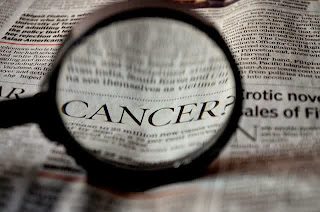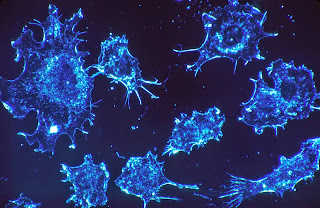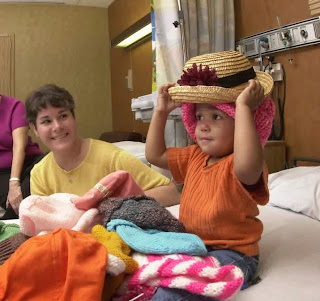What Is Cancer - Cancer is the name given to a set of related diseases. In all types of cancer, some of the body's cells begin to divide without stopping and spread to the surrounding tissues.
What Is Cancer

Image By
http://pixabay.com/p-389921/?no_redirect
The cancer can start almost anywhere in the body, which is made up of trillions of cells. Normally, human cells grow and divide to form new cells as the body needs them. When age or normal cells are damaged, they die, and new cells to replace them.
However, this orderly process goes awry in
cancer. As cells become more and more abnormal, old or damaged cells survive when they should die, and new cells form when they are not needed. These extra cells can divide without interruption and may form masses called tumors.
Many cancers are solid tumors, which are masses of tissue. Blood cancers, such as leukemias, do not form solid tumors in general.
Cancerous tumors are malignant, which means that they can spread to nearby tissues or they can invade them. In addition, these tumors grow, some cancer cells can break off and move to distant locations in the body via the circulatory system or lymphatic system and form new tumors away from the original tumor.
Unlike malignant tumors, benign tumors do not extend to nearby tissues and do not invade them. However, sometimes benign tumors can be quite large. To be removed, usually they do not grow, while malignant tumors do sometimes grow back. Unlike the majority of benign tumors in other parts of the body, benign brain tumors can endanger life.
Differences between cancer cells and normal cells
Cancer cells differ from normal cells in ways that allow them to grow out of control and become invasive. An important difference is that cancer cells are less specialized than normal cells. This means that, while normal cells mature in different cell types with specific functions, cancer cells do not. This is one reason why, unlike normal cells, cancer cells continue dividing without stopping.
In addition, cancer cells can ignore the signals that normally tell cells to stop dividing or to begin a process that is known as programmed cell death, or apoptosis, which uses the body to get rid of the cells that are not necessary.
Cancer cells may be able to influence the normal cells, molecules and in the blood vessels that surround and feed the cells of a tumor - an area that is known as the microenvironment. For example, cancer cells can induce normal cells close to forming blood vessels that supply oxygen and nutrients, necessary for tumors to grow. These vessels also withdrawn products disposed of tumors.
Cancer cells are often also able to evade the immune system, a network of organs, tissues and specialized cells that protects the body against infections and other diseases. Although ordinarily the immune system eliminates body damaged or abnormal cells, some cancer cells are able to "hide" from the immune system.
Tumors may also use the immune system to stay alive and grow. For example, with the help of some cells of the immune system that normally prevents an uncontrolled immune response, cancer cells can in fact make that the immune system does not destroy the cancer cells.
What Causes Cancer
Cancer is a genetic disease caused by changes in the genes that control the way how our cells, especially the way as grow and divide.
The genetic changes that cause cancer can be inherited from parents. They can also happen in the life of a person as a result of errors that occur when dividing cells or by the DNA damage caused by some exhibitions of the environment. Environmental exposures that cause cancer are substances, such as chemicals in tobacco smoke and radiation, such as ultraviolet rays of the Sun. (Our causes and risk factors of cancer page has more information).
Cancer each person has a unique combination of genetic changes. As the cancer continues to grow, additional changes occur. Even within each tumor, different cells have different genetic changes.
In general, cancer cells have more genetic changes, mutations in DNA as normal cells. Some of these changes may not be related to cancer; they can be the result of cancer and not its cause.
"Cause" cancer
The genetic changes that contribute to cancer tend to affect three main types of genes - proto-oncogenes, tumor suppressor genes and DNA repair genes. These changes "cause" cancer is sometimes called.
Proto-oncogenes are dedicated to the growth and normal cell division. However, when these genes are altered in certain ways or are more active than normal, they can become genes that cause cancer (u oncogenes), allowing the cells to grow and survive when they shouldn't.
The tumor suppressor genes are also dedicated to control growth and cell division. Cells with some alterations in the tumor suppressor genes can be divided in a way out of control.
DNA repair genes are dedicated to fix damaged DNA. Cells with mutations in these genes tend to form additional mutations in other genes. Together, these mutations can cause cells to become cancerous.
As scientists have learned more about the molecular changes that result in cancer, certain mutations have been found together in many types of cancer. Because of this, cancers are sometimes characterized as the types of genetic alterations that it believes are causing, not only by the site in the body where are formed and the way how the cancer cells look under a microscope.
When the cancer spreads
Cancer that has spread from where it started first to other parts of the body is called metastatic cancer. The process by which cancer cells spread to other parts of the body is called metastasis.
Metastatic cancer has the same name and the same type of cancer cells than the original or primary cancer. For example, cancer of the breast, or mama, which spreads to the lungs and forms a metastatic tumor is called metastatic breast cancer and non-cancer of the lung.
Looking at them under a microscope, metastatic cancer cells generally have the same appearance as the original cancer cells. In addition, metastatic cancer cells and the original cancer cells have usually some molecular characteristics in common, as the presence of specific changes in chromosome.
Treatment can help prolong the lives of some people with metastatic cancer. Although, in general, the main objective of the treatments for metastatic cancer is controlling the growth of the cancer or relieving the symptoms it causes. Metastatic tumors can cause serious damage to the functioning of the body, and the majority of people who die from cancer die from metastatic disease.
Non-cancerous changes in the tissues
Not all changes in the tissues of the body is cancerous. However, some changes can become cancerous if they are not treated. These are some examples of changes in tissues that are not cancerous, but in some cases, need to be monitored.
Hyperplasia occurs when tissue cells divide faster than normal and the additional cells accumulate or proliferate. However, the cells and the form is organized tissue are normal under a microscope. Hyperplasia can be caused by several factors or situations, even by chronic irritation.
Dysplasia is more severe than hyperplasia. Dysplasia there is also an accumulation of additional cells. But the cells are abnormal and there are changes in the way as the tissue is organized. In general, as more abnormal cells and tissue, are the bigger the possibility of the formation of cancer.
Some types of dysplasia may need to they monitor or to be treated. An example of dysplasia is an abnormal mole (called Dysplastic Nevus) which is formed in the skin. A Dysplastic Nevus can become melanoma, although most do not.
A more serious state is an in situ carcinoma. Although sometimes called cancer, carcinoma in situ is not cancer because abnormal cells do not extend beyond the original tissue. I.e., they do not invade the surrounding tissue as cancer cells do. But, since some carcinoma in situ become cancer, usually they are treated.
Types of cancer
There are more than 100 types of cancer. Cancers are, in general, of the organs or tissues where cancers are formed. For example, lung cancer begins in the cells of the lung and brain cancer begins in the cells of the brain. Cancers can also be described according to the type of cell that forms, such as epithelial cell or squamous cell.
Searchable on the web site of the National Cancer Institute information on specific types of cancer based on the location in the body or when using our list of cancers from A to Z. We also have information grouped on childhood cancers, cancers in adolescents and young adults, and cancers in women.
These are some categories of cancers that start in specific types of cells
Carcinoma
Carcinomas are the most common types of cancer. Formed in epithelial cells, which are cells that cover the internal and external surfaces of the body. There are many types of epithelial cells, which frequently have a way as column when seen under a microscope.
Carcinomas that start at different types of epithelial cells have specific names:
Adenocarcinoma is a cancer that forms in the epithelial cells that produce mucus or fluid. Tissues with this type of epithelial cells called glandular tissues sometimes. The majority of breast, colon and prostate cancers are adenocarcinomas.
Basal cell carcinoma is a cancer that begins in the lower or basal (at the base) layer of the epidermis, which is the outer layer of the skin of a person.
Squamous cell carcinoma is a cancer that forms in squamous cells, which are epithelial cells which are below the outer surface of the skin. Squamous cells are also many other organs, such as the stomach, intestines, lungs, bladder and kidneys. Squamous cells are flat, like fish scales, when seen under a microscope.
Transitional cell carcinoma is a cancer that forms in a type of epithelial tissue called epithelium of transition or Urothelium. This tissue, which consists of many layers of epithelial cells that can become big or small, is located in the lining of the bladder, ureters and part of the kidney (renal pelvis), and some other bodies. Some bladder, ureters and kidney cancers are transitional cell carcinomas.
Sarcoma
Sarcomas are cancers that are formed in the bone and soft tissues, indeed adipose (fatty) tissue, muscles, blood vessels, lymph vessels and fibrous tissue (such as tendons and ligaments).
Osteosarcoma is the most common bone cancer. The most common soft tissue sarcoma types are Leiomyosarcoma, Kaposi's sarcoma, malignant fibrous histiocytoma, liposarcoma and the dermatofibrosarcoma Protuberans.
Leukemia
Cancers that begin in the tissues that make up the blood in the bone marrow are leukemia. These cancers do not form solid tumors. Instead, a large number of white-blood cells, abnormal (Leukemic cells and Leukemic blast cells) accumulate in the blood and bone marrow and travel to the normal cells of the blood. The low concentration of normal blood cells can do that the body carry oxygen to the tissues, that is not controlling the bleeding or difficulty that no combat infections.
There are four common types of leukemia, which are grouped according to the speed with which worsens the disease (acute or chronic) and the type of blood cell where it starts (lymphoblastic or myelogenous) cancer.
Our leukemia page has more information.
Lymphoma
Lymphoma is a cancer that begins in the lymphocytes (T-cells or B-cells). These are white blood cells that fight disease and which are part of the immune system. In Lymphoma, abnormal cells accumulate in lymph nodes and lymph vessels, as well as other organs in the body.
There are two main types of lymphoma:
Hodgkin's lymphoma - people who have this disease have atypical lymphocytes which are called Reed-Sternberg cells. These cells are formed, in general, cell B.
Lymphoma non-Hodgkin - East is a large group of cancers that begin in cells. Cancers can grow quickly or slowly and they can form of B-cells or t-cells.
Our page on cancers of the blood (or blood) has more information.
Multiple myeloma
Multiple myeloma is a cancer that begins in plasma cells, another type of immune cells. The abnormal plasma cells called myeloma cells, accumulate in the bone marrow and form tumors in the bones of the body. Multiple myeloma is also called plasma cell myeloma and Morbus Kahler.
Our multiple myeloma and other plasma cell Neoplasms page has more information.
Melanoma
Melanoma is a cancer that begins in the cells that become melanocytes, which are specialized cells in producing melanin (the pigment that gives color to the skin). The majority of melanomas are formed on the skin, but can also form in other pigmented tissues, as in the eyes.
Brain and spinal cord tumors
There are different types of tumors of the brain and spinal cord. These tumors are called according to the cell type in where it formed and where the tumor was first formed in the central nervous system. For example, an astrocytic tumor begins in the cells of the brain that are star-shaped, and which are called astrocytes, which helps maintain healthy nerve cells. Brain tumors can be benign (not cancerous), or malignant (cancerous).
Other types of tumors
Germ cell tumors
Germ cell tumors are a type of tumors that begin in the cells that form the sperm or eggs. These tumors can occur almost anywhere in the body and may be benign or malignant.
Our page on germ cell tumors has more information.
Neuroendocrine tumors
Neuroendocrine tumors are formed from cells that secrete hormones into the blood in response to a signal from the nervous system. These tumors, which can produce hormones in larger than normal amounts, can cause many different symptoms. Neuroendocrine tumors can be benign or malignant.
Carcinoid tumors
Carcinoid tumors are a type of neuroendocrine tumors. They are tumors of slow growth that are usually found in the gastrointestinal tract (more frequently in the rectum and in the small intestine). Carcinoid tumors may spread to the liver or other sites in the body, and may secrete substances such as serotonin or prostaglandins cause Carcinoid syndrome.











